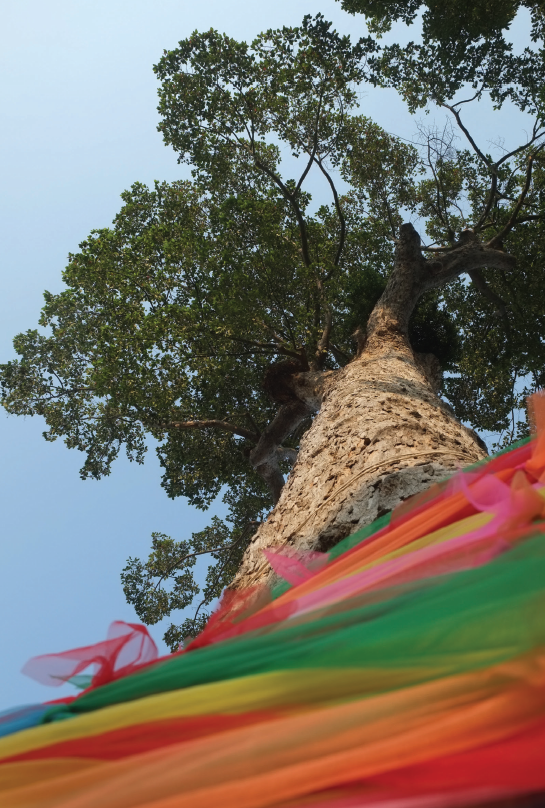การศึกษาพืชพรรณที่ปรากฏในภูมินามของหมู่บ้าน จังหวัดเชียงใหม่
Main Article Content
บทคัดย่อ
ภูมินาม หมายถึง คําท้องถิ่นที่ใช้เรียกชื่อสถานที่ ภูมินามของสถานที่แต่ละแห่งมีความเป็นมาแตกต่างกันโดยมีอิทธิพลของสภาพแวดล้อมในพื้นที่เข้ามาเกี่ยวข้อง คนในท้องถิ่นกําหนดภูมินามขึ้นเพื่อให้สามารถใช้สื่อสารถึงสถานที่ต่าง ๆ ได้จําเพาะเจาะจงและเกิดความเข้าใจตรงกัน บทความวิจัยนี้ มีวัตถุประสงค์ เพื่อรวบรวมและศึกษาพืชพรรณที่ปรากฏในภูมินามหมู่บ้านในจังหวัดเชียงใหม่ ตลอดจนวิเคราะห์การปรากฏของพืชพรรณในภูมินามในเชิงภูมิศาสตร์ และวิเคราะห์คุณค่าของพืชพรรณในภูมินามในฐานะเป็นเครื่องสะท้อนทางวัฒนธรรมและธรรมชาติของพื้นที่ โดยการเก็บข้อมูลจากเอกสารและข้อมูลภาคสนาม 2,066 หมู่บ้าน วิเคราะห์ตามแนวคิดทางคติชนวิทยาเกี่ยวกับภาษาพื้นบ้านและแนวคิดภูมินาม จัดจำแนกตามแนวคิดทางพฤกษศาสตร์พื้นบ้าน และวิเคราะห์ด้านภูมิศาสตร์โดยใช้การระบุพิกัดของหมู่บ้านที่มีพืชพรรณเกี่ยวข้องกับภูมินามลงในแผนที่ ผลการศึกษา แสดงให้เห็นว่า หมู่บ้านในจังหวัดเชียงใหม่ที่มีพืชพรรณปรากฏในภูมินามจำนวน 743 หมู่บ้าน เกี่ยวข้องกับพืชพรรณ 171 ชนิด โดยมะม่วงเป็นพืชพรรณที่ปรากฏมากที่สุดในภูมินาม และจากการศึกษาด้านภาษาที่ใช้ในภูมินามที่เกี่ยวข้องกับพืชพรรณ พบพืชพรรณที่ปรากฏอยู่ในภูมินามหมู่บ้านในจังหวัดเชียงใหม่ เป็นภาษาถิ่นภาคพายัพที่มีความสอดคล้องกับภาษาไทยจำนวนมากที่สุด รองลงมา ได้แก่ พืชพรรณในภูมินามที่เป็นภาษาถิ่นภาคพายัพที่ไม่ตรงกับภาษาไทย และพบภูมินามที่เกี่ยวข้องกับภาษากระเหรี่ยงและภาษาไทใหญ่อีกด้วย การจำแนกพืชพรรณในภูมินามในระดับวงศ์ พบจำนวน 68 วงศ์ โดยวงศ์ที่พบมากที่สุด ได้แก่ พืชวงศ์ถั่ว 18 ชนิด ปรากฏในภูมินาม 84 หมู่บ้าน และพืชวงศ์หญ้า 15 ชนิด ปรากฏในภูมินาม 93 หมู่บ้าน พืชพรรณในภูมินามส่วนใหญ่เป็นไม้ยืนต้น รองลงมา ได้แก่ ไม้พุ่ม ไม้เลื้อย ไม้น้ำ ไม้คลุมดิน และไม้อิงอาศัย ส่วนใหญ่เป็นพืชที่ใช้ประโยชน์ทางสมุนไพร รองลงมา ได้แก่ การใช้ประโยชน์ด้านการบริโภค พืชพรรณในภูมินามมีความสัมพันธ์กับความสูงจากระดับทะเลปานกลาง โดยเมื่อมีการเปลี่ยนแปลงระดับความสูงของพื้น จะมีเปลี่ยนแปลงของชนิดพันธุ์ที่ต่างออกไป สัมพันธ์กับระบบนิเวศป่าไม้ การศึกษาการกระจายตัวของหมู่บ้านที่มีพืชพรรณในภูมินามที่พบสูงสุด ได้แก่ มะม่วง และโพธิ์ พบว่า มีการกระจายตัวในแอ่งที่ราบในพื้นที่จังหวัดเชียงใหม่ สัมพันธ์กับการตั้งถิ่นฐานตามระบบนิเวศเกษตรกรรม การศึกษาภูมินามของหมู่บ้านมีคุณค่าต่อคนในท้องถิ่น โดยเฉพาะการตระหนักรู้ในคุณค่าของพืชพรรณและระบบนิเวศดั้งเดิมของพื้นที่ ซึ่งเชื่อมโยงไปถึงการนิยามตัวตนของผู้คนในชุมชน อันจะนำไปสู่การจัดการทรัพยากรและสภาพแวดล้อมที่เหมาะสมในแต่ละพื้นที่ได้
Article Details

อนุญาตภายใต้เงื่อนไข Creative Commons Attribution-NonCommercial-NoDerivatives 4.0 International License.
เอกสารอ้างอิง
Areekul, S. (2006). Ongkwamroo rueang phuet pa thi chai prayot thang paknuea khong Thai lem 1-3. (In Thai) [Knowledge of wild plants in northern highland of Thailand vol 1-3]. Chiang Mai: Amarin Printing Group Co.Ltd.
Bhumipamorn, S. (2003). Pra si maha pho: jak chom phuthaweep suvarnabhumi. (In Thai) [Bodhi tree: from India to Suvarnabhumi]. Bangkok: Toyota Thailand Foundation.
Chiangmai Provincial Social Development and Human Society Office. (2023). Kho moon tua pai changwat Chiang Mai pee 2566. (In Thai) [Genaral data of Chiang Mai province 2023]. Chiang Mai: The Chiangmai Provincial Office of the Comptroller General’s Department.
Clayton, W.D. & Renvoize, S.A. (1986). Genera graminum: grasses of the world. London: Royal Botanic Gardens
Department of Forertry. (2004). Karn pattana sappaya korn maiphai yangyunyuen. (In Thai) [Sustainable depeloping in bamboo resources]. Chiang Mai: Department of Forestry.
Dokrak, M. & Koodin, U. (2009). Niwet wittaya pamai. (In Thai) [Forest ecology]. Bangkok: Kasetsart University.
Edwards, D., et al. (2012). Public preferences for structural attributes of forests: towards a pan-European perspective. Forest Policy and Economics, 19, 12–19.
Fueangworatham, A. (2001). Kued: koh ham nia Lanna. (In Thai) [Taboo: prohibition in Lanna Culture]. Chiang Mai: social Reserch Institute of Chiang Mai University.
Gardner, S., Sidisunthorn, P. & Anusarnsunthorn, V. (2000). A field guide to forest trees of northern Thailand. Bangkok: Kobfai Publishing.
Heywood, V. H. (1993). Flowering plants of the world. Oxford: Oxford University Press.
Intharaksa, A. (2019). Samoonprai lae pakpuenbaan Lanna. (In Thai) [Lanna local vegetabel and herb]. Bangkok: Medicinal Plant Innovation Center, Chiang Mai University.
Joye, Y. (2007). Architectural lessons from environmental psychology: the case of biophilic architecture. Review of General Psychology, 11(4), 305–328.
Kongkarnda, C. (1999). Wattanatham Thai kab mai wong yang. (In Thai) [Thai culter and plants in dipterocarpaceae]. Bangkok: Kasetsart University.
Kulawanich, P. (1992). Chue moobaan nai mon ton Guangxi lae pak ta wan aok chiang nue kong prathet Thai. (In Thai) [Villages names in Guangxi China and northeastern Thailand]. Bangkok: University of Chulalongkorn.
Olarn, R., & Wimolsiri, K. (2009). Poomminam kong moobaan nai changwat Lampang. (In Thai) [Village typonym in Lampang province]. Journal of the Faculty of Arts, Silpakorn University, 31(2), 26–61.
Pankhuenkhat, R. (2011). Pasasat pasa Thai. (In Thai) [Thai linguistics]. Bangkok: Mahachulalongkornrajavidyalaya.
Piyapakorn, P. (1989). Poomminam khong moobaan chonnabot nai changwat Chaiyaphum. (In Thai) [Toponym of villege in Chaiyaphum province]. Journal of Geography, 14(3), 177–182.
Piyapakorn, P. (1994). Poomminam karn tangtintan moobaan chonnabot nai paktawanaok chiang nue: wikroh roop bab tang poo mi sat khong nam tua pai. (In Thai) [Toponym and settlement of villege in north-eastern: geographical analysis in general toponym]. Journal of Language and Culture, 13(2), 49–60.
Ratchalet, T., Yipmantasiri, P & Uthumphan, R. (2003). Mamuangkeaw: maiphon phuea kwamwang lae fuen foo sub pa ya korn tam ma chat. (In Thai) [Mango: fruit for hope and natural resources restoration]. Bangkok: Matichon Publishing.
Rungsan, C. (2009). Baan, long lae mueng - kate kwamsampan bon tan settakit lae wattanatham choom chon nai ang Chiang Mai - Lampoon. (In Thai) [Village, plain and city - region of economical and cultural reationship in Chiang Mai-Lampoon upper basin]. Bangkok: The Thailand Research Fund.
Sansanee, S., Kochai, S., & Runsan, C. (2016). Poomminam tongthin: tima kwammai lae attalak kong chue moobaan nai amphoe Hang Dong, changwat Chiang Mai. (In Thai) [Toponym: origin meanning and Indentity of village name in Hang Dong district, Chiang Mai province]. Ganesha Journal, 12(2), 43–51.
Saowalak, A. (2000). Thruesadi ka ti chon wittaya lae karnsueksa. (In Thai) [Folkloristics and study metod]. Bangkok: Ramkamhang University Publisher.
Thammathi, S. (2015). Lanna prueksa kadee. (In Thai) [Story of plant in Lanna]. Chiang Mai: Suthep Karnpim and Media.
Turland, J., et al.(2018). International code of nomenclature for algae, fungi, and plants. Oberreifenberg: Koeltz botanical books.
Wonglangka, W. (2013). Mai mai mueang Chiang Mai: khati khwam chue rueang tonmai kap karn mai thinthan. (In Thai) [Land-marking tree of Chiang Mai: believes of plant and place marking]. In Srisuwan, C. (Ed.). Mueang Chiang Mai: sinlapa sathapattayakam lae khwamchuea. (In Thai) [Chiang Mai: art, architecture and believes] (pp. 69–89). Chiang Mai: Lanna Architectural Center.
Wonglangka, W., & Han, F. (2018). Wat Lanna: phumithat watthanatham kap karn pen phuenthi sikhiao nai mueang. (In Thai) [Lanna Buddhist temple: the cultural landscape as urban green space]. Journal of Environmental Design, 5(1), 106–129.


